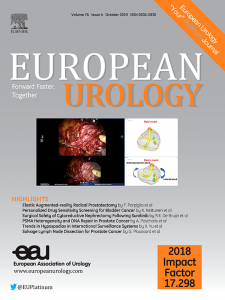Use of the Xpert Bladder Cancer Monitor Urinary Biomarker Test for Guiding Cystoscopy in High-grade Non–muscle-invasive Bladder Cancer: Results from the Randomized Controlled DaBlaCa-15 Trial
IF 25.2
1区 医学
Q1 UROLOGY & NEPHROLOGY
引用次数: 0
Abstract
Background and objective
Urinary biomarker tests have long been suggested as a noninvasive alternative to current cystoscopy-based follow-up of high-grade non–muscle-invasive bladder cancer (NMIBC) to reduce both morbidity and costs. However, the clinical impact of urinary biomarker tests remains uncertain owing to a lack of randomized trials.
Methods
In this randomized noninferiority trial, we evaluated the impact of alternating a urinary biomarker test (Xpert Bladder Cancer Monitor, XBCM) with cystoscopy in the intervention arm as a method for reducing the number of cystoscopies during follow-up of patients with high-grade NMIBC. Patients in the control arm underwent cystoscopy at all follow-up visits. The primary outcome was comparison of the risk of recurrence-free survival in terms of high-grade NMIBC, muscle-invasive bladder cancer, or metastatic urothelial carcinoma between the study arms.
Key findings and limitations
In total, 43 high-grade recurrences were detected, 22 in the intervention arm and 21 in the control arm. The risk difference for high-grade recurrence between the study arms was 0.08% (95% confidence interval −7.2% to 7.4%). Two pTa high-grade recurrences were missed by the XBCM test. The number of cystoscopies performed was 1029 cystoscopies in the control arm and 445 in the intervention arm. An anticipatory positive effect was observed, with XBCM positivity observed before recurrences were visible on cystoscopy. The findings are limited by a lower-than-expected rate of recurrence in both study arms.
Conclusions and clinical implications
Alternating cystoscopy with XBCM reduced the number of follow-up cystoscopies for high-grade NMIBC without affecting detection of any recurrence. The long-term oncological safety of this strategy needs to be validated over longer follow-up.
使用Xpert膀胱癌监测尿液生物标志物测试指导膀胱镜检查高度非肌肉侵袭性膀胱癌:来自随机对照DaBlaCa-15试验的结果
背景和目的长期以来,泌尿生物标志物检测一直被认为是目前基于膀胱镜的高级别非肌肉浸润性膀胱癌(NMIBC)随访的一种无创替代方法,以降低发病率和成本。然而,由于缺乏随机试验,尿液生物标志物检测的临床影响仍然不确定。方法:在这项随机非劣效性试验中,我们评估了在干预组交替进行尿液生物标志物检测(Xpert膀胱癌监测,XBCM)和膀胱镜检查的影响,作为一种减少随访期间高度NMIBC患者膀胱镜检查次数的方法。对照组患者在所有随访中均接受膀胱镜检查。主要结局是比较研究组之间高级别NMIBC、肌肉侵袭性膀胱癌或转移性尿路上皮癌的无复发生存风险。主要发现和局限性总共检测到43例高级别复发,干预组22例,对照组21例。两组间高级别复发的风险差异为0.08%(95%可信区间- 7.2%至7.4%)。XBCM检查未发现2例pTa高级别复发。对照组膀胱镜检查次数为1029次,干预组为445次。观察到预期的积极作用,膀胱镜检查可见复发前观察到XBCM阳性。这一发现受到两个研究组的复发率低于预期的限制。结论及临床意义:XBCM交替膀胱镜检查减少了高级别NMIBC的随访膀胱镜检查次数,且不影响发现任何复发。该策略的长期肿瘤学安全性需要在更长的随访中得到验证。
本文章由计算机程序翻译,如有差异,请以英文原文为准。
求助全文
约1分钟内获得全文
求助全文
来源期刊

European urology
医学-泌尿学与肾脏学
CiteScore
43.00
自引率
2.60%
发文量
1753
审稿时长
23 days
期刊介绍:
European Urology is a peer-reviewed journal that publishes original articles and reviews on a broad spectrum of urological issues. Covering topics such as oncology, impotence, infertility, pediatrics, lithiasis and endourology, the journal also highlights recent advances in techniques, instrumentation, surgery, and pediatric urology. This comprehensive approach provides readers with an in-depth guide to international developments in urology.
 求助内容:
求助内容: 应助结果提醒方式:
应助结果提醒方式:


